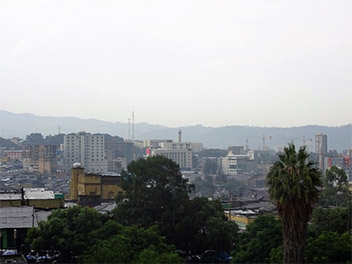 |
 |
 |
 |
notes from the field
These field notes are personal views and do not necessarily reflect the views of Red Cross/Red Crescent Climate Centre
Katie Chambers
Ethiopia
June - August, 2017
From Top-Down Mapping to Bottom-Up Solutions
June 19, 2017
View photo gallery for more photos from the field by Katie Chambers
 These past couple weeks have been full of meetings that have taken me across Addis Ababa to coordinate the project’s organizational stakeholders, including the Ethiopian Red Cross Society, Ministry of Water, National Meteorological Agency, Netherlands Red Cross, Canadian Red Cross, Awash River Basin Authorities, and (of course) the Climate Centre. Each organization has an interest in my work, ranging from existing projects in the Awash River Basin to using my findings to help develop a countrywide disaster response framework. While this coordination adds to my summer’s workload, knowing that I have the support, encouragement, and interest of so many individuals and organizations has given me the confidence and reassurance that the project will be successful and impactful.
These past couple weeks have been full of meetings that have taken me across Addis Ababa to coordinate the project’s organizational stakeholders, including the Ethiopian Red Cross Society, Ministry of Water, National Meteorological Agency, Netherlands Red Cross, Canadian Red Cross, Awash River Basin Authorities, and (of course) the Climate Centre. Each organization has an interest in my work, ranging from existing projects in the Awash River Basin to using my findings to help develop a countrywide disaster response framework. While this coordination adds to my summer’s workload, knowing that I have the support, encouragement, and interest of so many individuals and organizations has given me the confidence and reassurance that the project will be successful and impactful.
With site visits and community-based research beginning next week, I am making the transition from office to field work. The transition isn’t only a shift in the work I’m performing, but a shift in mentality. A recurrent lesson through all my development classes and fieldwork is the importance of community participation. As engineers and development practitioners, we’re sometimes so focused on solving a problem that we forget to engage with the very people we’re trying to solve the problem for. Case studies have shown that even perfectly designed systems failed when communities were not actively engaged throughout the project process. For example, researchers from CU Boulder found that during the post-disaster shelter reconstruction following the 2004 Indian Ocean tsunami, latrines were installed attached to homes. While the toilets were structurally sound and functional, they went unused due to homeowners’ fears that they would cause bad odors in the house (Jordan, Javernick-Will, & Amadei, 2015).
The flood models developed in the project’s first phase are not the solution to the problem my summer work addresses. Disaster preparedness plans should be informed by bottom-up participatory approaches, with models to guide planning. This allows for a more realistic approach, guided by a community’s identification of priorities and threats. The coming weeks will be busy, filled with fieldwork and the refinement of the flood models. Apologies for the lack of pictures accompanying this blog post, but with fieldwork coming up I’ll be sure to make up for it!
Jordan, E., Javernick-Will, A., and Amadei, B. (2015). Post-disaster reconstruction: lessons from Nagapattinam district, India. Development in Practice, 25(4), 518–534.

